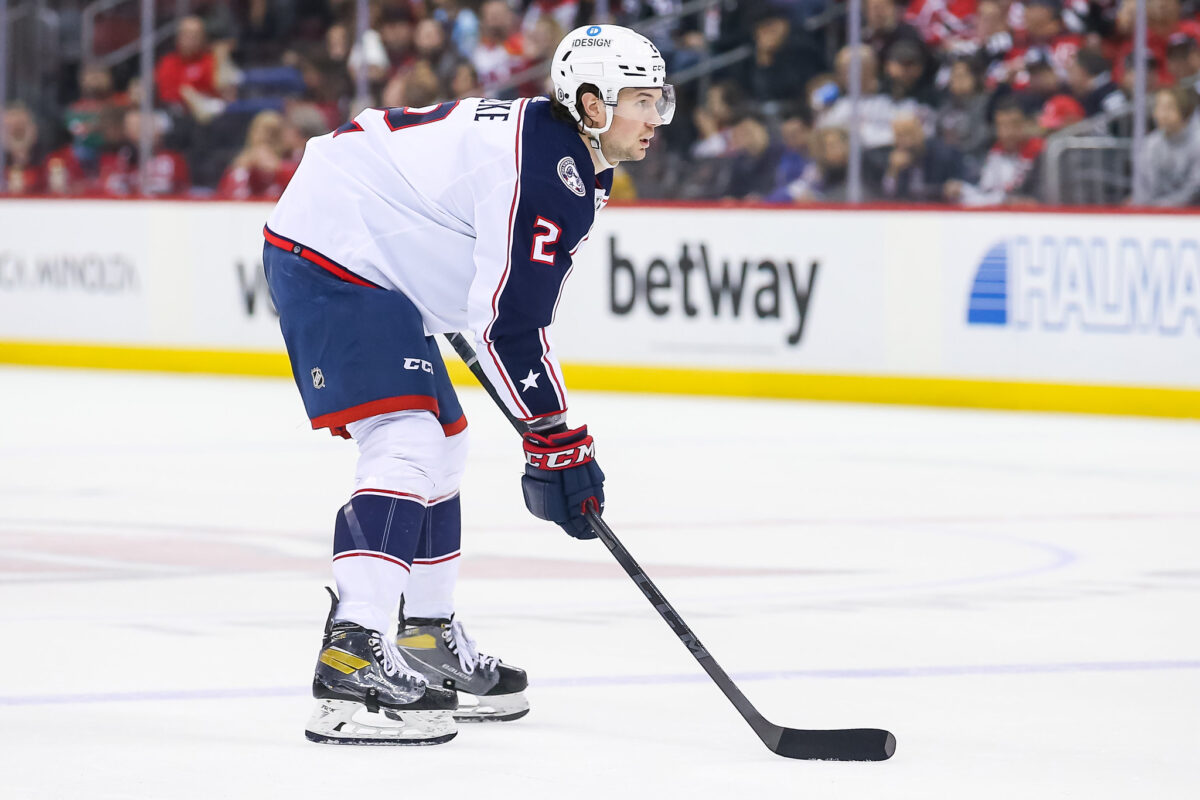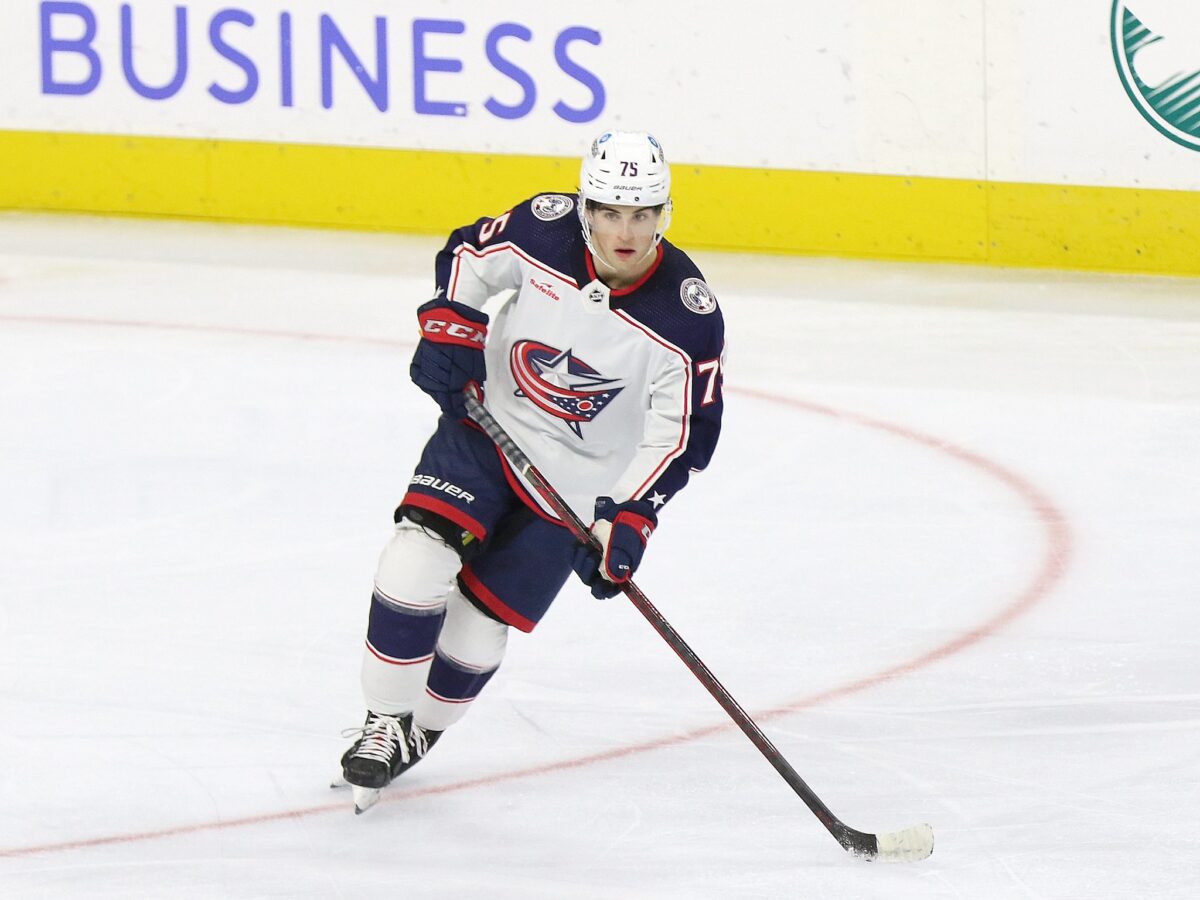The Columbus Blue Jackets have a rare problem: they have too many NHL defenders in their organization. It was the opposite problem for general manager Jarmo Kekalainen last season as their barren blue line was exposed after top defenseman, Zach Werenski, was out for the season. Once he was lost, the rest of the defensive corps were always punching above their weight class and it led to one of the worst defensive seasons in franchise history.
Kekalainen has remedied the situation by adding some elite depth in his trades for Ivan Provorov and Damon Severson. However, those additions plus Werenski’s return push out three players who were penned into the top-six. So now there are nine players who played a full-time role in the NHL last season and only six spots for them to fit into. The problem is exacerbated by the progress of prospect David Jiricek, who had a strong year in the American Hockey League (AHL) and will push for an NHL roster spot in October.
Needless to say, the current depth chart for the Blue Jackets’ defense is a little crammed. This is something that I broke down in-depth in a previous article. There haven’t been any changes since then, so this is the chart that I stand by.
| Pairings | Left Defense | Right Defense |
| 1st | *Zach Werenski | *Damon Severson |
| 2nd | *Ivan Provorov | Adam Boqvist |
| 3rd | Nick Blankenburg | *Erik Gudbranson |
| Spare | Jake Bean | Andrew Peeke |
| Spare | Tim Berni | David Jiricek |
As you can see, on any given night there will be at least four players who could play meaningful minutes out of the lineup. Granted, injuries could be a factor again this season, but that doesn’t mean the Jackets shouldn’t consider moving a piece or two from that list so everyone is comfortable. It wouldn’t be the end of the world if they chose to convert some of the value from their current depth chart into either draft capital, prospects, or current assets to improve the roster in other places. So, who are the top candidates to be moved?
We’ll be looking at some combination of who has the most trade value, who is the most expendable, and who has the best contract situation. Of course, there are a few untouchable players who are removed from the conversation like Werenski, Provorov, Severson, and Jiricek. Now, let’s have a look at the Blue Jackets’ three most tradeable defensemen and what their return might be.
Andrew Peeke
There’s a lot of value in today’s NHL for a 6-foot-3, legitimate top-six, and right-shot defenseman on a team-friendly contract with term. Those are exactly the boxes checked by Andrew Peeke.
Over the last two seasons, Peeke, 25, has become a defensive specialist for the Blue Jackets. He’s not only a physical presence, with almost 200 hits and blocked shots in each season, but is also durable, having only missed two games over that stretch. He was often their most reliable defender when the 2022-23 roster was decimated by injury, especially after the trade of Vladislav Gavrikov.

Yes, he posted a minus-41 rating which was one of the worst in the NHL. But let’s remember that he was supported by arguably a league-worst team defense and a majority of his assignments were in the defensive zone. That rating is a little inflated and would be drastically improved in a better system with stronger support around him.
He is also an attractive asset from a contract perspective. He’s got another three years remaining on a deal worth $2.75 million per year. That cost certainty for a player used to munching over 21 minutes of ice time per night could be incredibly valuable to a contender under tight cap constraints this season.
The return on Peeke is a tough one to gauge. He could fetch anywhere from a third-round pick to a late first-round pick. It all depends on when a trade is made and to what team. For the right team, Peeke could be the missing piece on the blue line that puts them over the top. He strikes me as the type of player who could warrant a surprisingly high return at the trade deadline like in the Tampa Bay Lightning’s trades for Barclay Goodrow, Tanner Jeannot, and Brandon Hagel. He could also be a guy that because he’s unproven in any sort of winning environment might only draw a mid-round pick. I would imagine Kekalainen doesn’t move Peeke until he gets a higher return, since with his contract term there’s certainly no rush.
Adam Boqvist
The tantalizing offensive skill of Adam Boqvist has put his name out there as a trade target for almost every team looking for a right-shot defenseman. In his draft year, the comparisons to Norris Trophy winner Erik Karlsson were abundant. After four years in the NHL, reaching that high bar is not entirely out of the question.
Related: Sharks Should Target Adam Boqvist as Karlsson Replacement
Similar to Karlsson, the 6-foot defender is a specialist in the other team’s end. When he has the puck on his stick, people wait with bated breath to see what sort of clever move he will bring out of his bag of tricks. Whether it’s a nifty deke, a seeing-eye pass, or a nicely placed wrist shot, there’s almost always a feeling something exciting could happen. The problem is that when he doesn’t have the puck, it’s easy to forget that he is on the ice.
The return on Boqvist would be high. He’s a recent top-ten pick, who at 22 years old has played almost 200 games and scored 75 points. There are not many defenders in the NHL with that many points at that age, let alone with that many games played. There is a ton of promise there even if he doesn’t figure out the defensive side of the puck. He could become an offensive specialist as we’ve seen Tony DeAngelo carve out a pretty decent niche in that role. However, if Boqvist does figure out the defensive side of the game, watch out. I would imagine the return at this stage of his career would be a mid-to-late first-round pick or a package of mid-round picks and a prospect or two.
Tim Berni
The Blue Jackets’ injury situation last season was tough on their position in the standings, however, it did benefit a few specific players in their system. One such player was Swiss-born Tim Berni.
Berni, 23, likely wouldn’t have had more than a cup of coffee at the NHL level last season, but because of injury wound up dressing in 59 games. He worked up an instant chemistry with Erik Gudbranson and spent much of his time flanking the grizzled veteran. As a defense-first guy, he played a regular role averaging just under 17 minutes a night. He strikes me as a similar player to Scott Harrington, a solid depth piece with nothing particularly eye-popping about his game and he wouldn’t be much more than a seventh or eighth defender on a contending team.

A trade for Berni comes at the intersection of a soon-to-be favorable contract situation and a low acquisition cost. He is currently without a contract as a restricted free agent (RFA) having rejected the Blue Jackets’ qualifying offer. Having earned an NHL salary for most of last season, you’d have to imagine that part of what his camp is looking for is a one-way contract. However, with a minus-26 rating and only three appearances on the scoresheet, the chances of that are probably 50-50. Regardless, his cap hit should still wind up around the $1 million mark which would be easy for any team to absorb.
At the end of the day, the return would be low. We’re talking a sixth or seventh-round draft pick or a fringe NHL prospect at best. The only real reason for Kekalainen to consider this trade would be to either free up a spot in the organizational depth chart or to give Berni more of a shot at a regular top-six role with an NHL team. With the way things are trending in the Jackets’ organization, if there are no defensemen traded and less than an injury or two at a time, his games played last season will probably end up being a career-high. As such, greener pastures for Berni would be through a change of scenery.
The Blue Jackets have a couple more roster decisions to make before the new season rolls around. The logjam on defense was only made worse in the offseason and so it would not be a shock to see one or two defensemen shipped out before October. Peeke, Boqvist, and Berni are all players who would have a list of suitors on the trade market and meet other criteria that make them the team’s three most tradeable defenders.